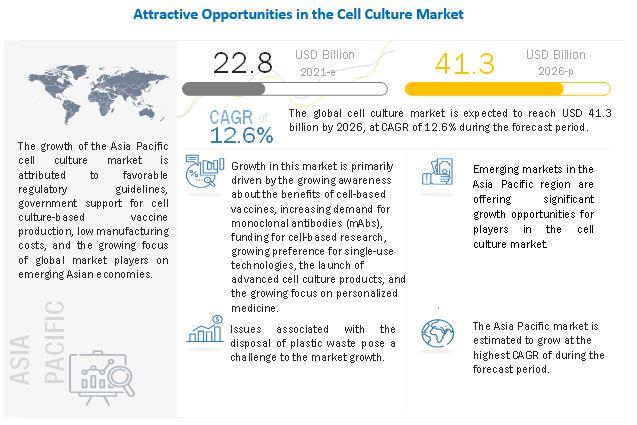The global Cell Culture Market is projected to reach USD 51.3 billion by 2028 from USD 27.9 billion in 2023, at a CAGR of 12.9% during the forecast period of 2023 to 2028. The growth of this market is majorly driven by the government support and funding for cell-based research, and emerging cell culture technologies for cell-based vaccines. On the other hand, the limitations in producing high-density cell cultures is restraining the growth of this market.
Download PDF Brochure: https://www.marketsandmarkets.com/pdfdownloadNew.asp?id=559
Browse in-depth TOC on "Cell Culture Market”
692 – Tables
42 – Figures
556 – Pages
Key Player
The global cell culture market is a consolidated market, with Thermo Fisher Scientific (US), Danaher Corporation (US), Merck KGaA (Germany), Sartorius AG (Germany), Corning Incorporated (US).
DRIVERS: Adoption of single-use technologies
Over the last few years, biopharmaceutical manufacturers have increasingly adopted single-use technologies (SUTs). These SUTs have helped comply with stringent regulations and control costs through multiple benefits. Some single-use bioreactors (SUBs) have low operating volume requirements; this allows for more flexibility in production volumes scaled up over time, depending on the demand. Also, SUTs reduce cross-contamination risk, facilitating rapid changeovers and multiple production batches. SUTs also require less space than multiple-use bioreactors, less capital investment, and less sterilization for storage. This reduces the overall operating and maintenance costs and the environmental impact of these operations. The advantages of SUTs have fueled their adoption in the biopharmaceutical sector, thus driving the growth of the overall market during the forecast period.
RESTRAINTS: Limitations in producing high-density cell cultures
Although the adoption of advanced technologies such as microcarriers is increasing in high-density cell cultures, there are several limitations associated with their use, which makes the process of cell culture very laborious and expensive. Some of them are: Agitation is required in a stirred-tank bioreactor to make a homogenous cell culture system. Fluid turbulence damages cells and results in cell debris formation and low cell yield, thus increasing downstream processing costs. The number of microcarriers needs to be increased for higher culture density. This, however, leads to a higher degree of collisions (bead-to-bead or microcarrier-bound-cells to mechanical impeller), resulting in cell death and decreased cell yield.
OPPORTUNITIES: Growth hotspots in emerging economies
Developing countries such as China, India, and other countries in the Asia Pacific are expected to offer significant growth opportunities for players operating in the market. The booming biopharmaceutical sector in these countries, increased risk of pandemics (such as swine flu and COVID-19), less-stringent regulatory guidelines, and the low manufacturing cost advantage are the major factors attracting market players to set up and expand their presence in these countries.
CHALLENGES: Disposal of plastic consumables
Cell culture relies heavily on plastic consumables, resulting in the generation of large amounts of plastic waste each year. This has had a negative impact on the environment. However, there are still serious concerns about the disposal of solid waste materials generated by this alternative technology. The majority of single-use bioprocessing systems are constructed of multiple materials or layers, such as polyethylene (PE), polypropylene (PP), ethylene vinyl alcohol, or nylon. Recycling is not an option for such products because separating the components into homogeneous components requires significant effort. As a result, the majority of single-use systems and their components are unsuitable for recycling.
The sera, media, and Reagents subsegment of the consumables segment dominated cell culture market.
Based on consumables, the market is segmented into sera, media, & reagents, vessels, and accessories. Cell cultures are used in laboratories for various applications, such as biopharmaceutical production, vaccine production, toxicology, and drug discovery. Sera, media, and reagents are an integral part of cell culture experiments and help in yielding better results. These products are required for cell culturing and expansion. Increasing government initiatives for enhancing cell-based research and investments by companies to develop advanced products are contributing to the growth of the overall market, which in turn is driving the demand for consumables, including sera, media, and reagents.
Inquiry Before Buying this Report: https://www.marketsandmarkets.com/Enquiry_Before_BuyingNew.asp?id=559
Recent Developments:
- In October 2021, Thermo Fisher Scientific Inc. (US) launched the Gibco Cell Therapy Systems (CTS) NK-Xpander Medium, which supports the large-scale growth and culture of functional natural killer (NK) cells with or without the use of feeder cells.
- In September 2021, Cytiva expanded its manufacturing capacity for bioprocessing single-use consumables by launching 3 new manufacturing facilities in under ten months.
Get 10% Free Customization on this Report: https://www.marketsandmarkets.com/requestCustomizationNew.asp?id=559
About MarketsandMarkets™
MarketsandMarkets™ provides quantified B2B research on 30,000 high growth niche opportunities/threats which will impact 70% to 80% of worldwide companies’ revenues. Currently servicing 7500 customers worldwide including 80% of global Fortune 1000 companies as clients. Almost 75,000 top officers across eight industries worldwide approach MarketsandMarkets™ for their painpoints around revenues decisions.
Our 850 fulltime analyst and SMEs at MarketsandMarkets™ are tracking global high growth markets following the "Growth Engagement Model – GEM". The GEM aims at proactive collaboration with the clients to identify new opportunities, identify most important customers, write "Attack, avoid and defend" strategies, identify sources of incremental revenues for both the company and its competitors. MarketsandMarkets™ now coming up with 1,500 MicroQuadrants (Positioning top players across leaders, emerging companies, innovators, strategic players) annually in high growth emerging segments. MarketsandMarkets™ is determined to benefit more than 10,000 companies this year for their revenue planning and help them take their innovations/disruptions early to the market by providing them research ahead of the curve.
MarketsandMarkets’s flagship competitive intelligence and market research platform, "Knowledge Store" connects over 200,000 markets and entire value chains for deeper understanding of the unmet insights along with market sizing and forecasts of niche markets.
Contact:
Mr. Aashish Mehra
MarketsandMarkets™ INC.
630 Dundee Road
Suite 430
Northbrook, IL 60062
USA: +1-888-600-6441
Email: [email protected]
Research Insight: https://www.marketsandmarkets.com/ResearchInsight/cell-culture-market.asp
Visit Our Website: https://www.marketsandmarkets.com/
Content Source: https://www.marketsandmarkets.com/PressReleases/cell-culture.asp
Related Reports:
